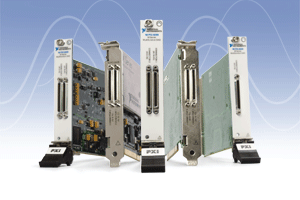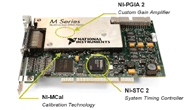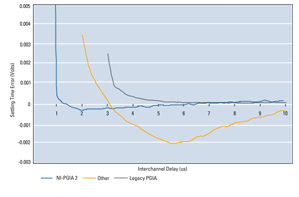NI’s Next Generation in Data Acquisition
Engineers always demand more I/O and greater performance from their plug-in DAhardware. Now they can get it.
Latest News
December 1, 2004
By Bill Boldt
The M Series is the next generation of multifunction DA (dataacquisition) devices from National Instruments (NI). In designing thenew M Series DA devices, NI enhanced and improved the capabilities ofits industry-standard DA hardware, incorporating features andtechnologies new to plug-in DA.
The key improvement, according to NI, is an all-newsystem-timingcontroller at the core of all M Series devices. This chip, the NI-STC2, offers performance features previously unavailable on plug-in DAhardware. Additionally, a unique calibration scheme and new generationof programmable gain instrumentation amplifiers improve measurementaccuracy across the entire measurement range and enable fasteracquisition rates than earlier devices. M Series devices lower the costof multifunction DA by offering more performance and flexibility, plusthe increased number of channels per device lowers the cost per I/Ochannel for both analog and digital signals.
Core Specs
All devices in the M series—20 at press time—have a minimum of 16analog inputs, 24 digital I/O lines, and two counter/timers. Devicesare also available with up to four analog outputs, 32 analog inputs,and 48 digital lines.


Figure 1: The new M Series plug-in DA boards from National Instruments offernew technologies said to provide more performance,more I/O, and at lower costs.
System Timing Controller
The NI-STC 2 is a custom-designed ASIC (application-specific integratedcircuit) that controls internal and external synchronization and timingfor multifunction DA operations. The NI-STC 2 manages all digitalsignals on the device, including inputs from the ADC (analog-to-digitalconverter), outputs to the DAC (digital-to-analog converter), digitalI/O lines, and counter/timers. The NI-STC 2 was also designed to becompatible with the latest ADC technology, including 18-bit ADCs.
In addition to providing more digital I/O lines, the NI-STC 2 offerssix DMA (direct memory access) channels dedicated to I/O operations.What this means is that all six operations on the device—analog input,analog output, digital input, digital output, counter/timer 0, andcounter/timer 1—can execute simultaneously on their own dedicated DMAchannel. This in turn improves execution speed and data throughput whenyou perform multiple operations simultaneously.
Previously, the standard for DA devices was limited to three DMAchannels. For example, E Series devices offered the ability to use DMAchannels for three simultaneous operations such as analog input, analogoutput, and one counter/timer. This left the digital input, digitaloutput, and other counter/timer operations to use interrupts for datatransfer, which severely reduced performance. The M Series does nothave such limitations, making it possible for use in time-criticalcontrol applications that require all of the I/O functionality of thedevice to be used simultaneously.
Additionally, you can correlate some of the digital lines with otherI/O, enabling synchronization between digital and analog I/O as well assynchronization with internal or external clock sources for timeddigital I/O rates up to 10MHz. Previously, with E Series devices, itwas not possible to synchronize digital I/O operations with the analogI/O operations because the digital I/O was controllable only throughsoftware timing. The NI-STC 2 also incorporates two 80MHz, 32-bitcounter/timers with built-in encoder support. Legacy devicestraditionally offered 20MHz, 24-bit counter/timers, which did not fullysupport quadrature encoder measurements.

Figure 2: NI-PGIA 2 technology provides faster settling times than legacy andearlier-generation off-the-shelf PGIA technologies.
Custom Gain Amplifier
To improve analog measurement accuracy, NI redesigned its programmablegain instrumentation amplifiers (PGIAs) and, to insure accurate analogmeasurements, the M Series leverages NI-PGIA 2 technology. Each familyof M Series boards has a specific NI-PGIA 2 that is optimized for cost,speed, and accuracy. NI-PGIA 2 technology improves accuracy byminimizing settling time. (Settling time is the amount of time requiredfor a signal that is being amplified to reach a specific level ofaccuracy.) Minimizing amplifier settling time allows high-speedacquisition without sacrificing accuracy.
Nonlinearities and drift due to time and temperature characterizeelectronic components such as ADCs and programmable amplifiers. Yourequire device self-calibration to compensate for these inherentsources of error. Legacy DA devices use an onboard precision voltagereference to perform a 2-point calibration for a single measurementrange. This method fails to protect against localized nonlinearitiesover the range of the ADC, which diminishes the device’s measurementaccuracy. Additionally, this method calibrates at only a single inputrange. Thus, the tolerance of a resistor network limits the accuracy ofmeasurements that scan multiple channels at varying input ranges.
Calibration Using PWM
M Series devices incorporate NI-MCal technology, a patent-pendinglinearization and calibration engine, which calibrates at thousands ofvoltage levels and at all input ranges. NI-MCal uses pulse widthmodulation (PWM) in conjunction with a high-precision voltagereference. The PWM duty cycle is used to vary the voltage level,providing self-calibration at multiple points. Calibration constantsare generated and stored in an onboard EEPROM to model the nonlinearityof the ADC and to correct subsequent measurements.
The implementation of NI-MCal technology improves measurement accuracyup to five times when compared to traditional 2-point calibration foundin E Series and other legacy DA devices. Additionally, the improvedprecision reference on most M Series devices lowers the maintenancecost of the device by increasing the recommended calibration intervalfrom one year to two years (see Table 1, below).
Table 1: M Series versus Legacy Device Calibration
| M Series | Legacy Devices |
Type of calibration | Polynomial, all input ranges | Linear, one range |
Typical self-calibration time | 7s | 30s |
Calibration interval requirement | Up to 2 years | 1year |
Measurement Services Software
Many DA devices come with just a basic DA device driver. Some deviceseven require the separate purchase of driver software just for basicfunctionality. All M Series devices include NI-DAQmx measurementservices and the appropriate driver software. Plus, it works withLabVIEW seamlessly.
NI-DAQmx measurement services software controls every aspect of your DAsystem, from configuration to programming to low-level operating systemand device control. Its basic premise is to help you configure andacquire measurements quickly. NI-DAQmx also offers virtual channelsthat automatically scale data into engineering units. Its DAQ Assistantutility lets you configure DA applications without programming, and itautomatically generates code.
Hyperthreading and Smart Sensors
M Series devices leverage both hyperthreading and multithreadingtechnologies fully. M Series devices controlled by the NI-DAQmxmeasurement services software can execute multiple operations (i.e.,threads) simultaneously on a single PC processor. M Series devices alsouse hyperthreading, available on high-end PCs, which expands onmultithreading by simulating multiple processors at a very low hardwarelevel.
M Series DA devices conform to IEEE 1451.4 smart sensorsstandardization. By combining M Series DA devices, NI signalconditioning, and NI-DAQmx measurement services software to read smartsensors, you eliminate manual sensor data entry by automaticallyreading the electronic data sheet for a sensor and using that data toautomatically scale sensor measurements.
NI believes that its new M Series DA devices offer a new standard forfunctionality and performance while lowering the cost of dataacquisition. When examining the additional I/O available on the MSeries, the price per I/O channel has dropped by more than 30 percent.The NI-STC 2, NI-MCal, and NI-PGIA 2 technologies provide features andperformance that were previously unavailable for plug-in DA devices.
Bill Boldt is a data acquisition systems engineer for NationalInstruments in Austin, TX. You can send Bill your comments about thisarticle c/o de-feedback
@helmers.com.
Product Information
M Series DA Devices
National Instruments
Austin, TX
ni.com
Subscribe to our FREE magazine, FREE email newsletters or both!
Latest News
About the Author
DE’s editors contribute news and new product announcements to Digital Engineering.
Press releases may be sent to them via [email protected].






